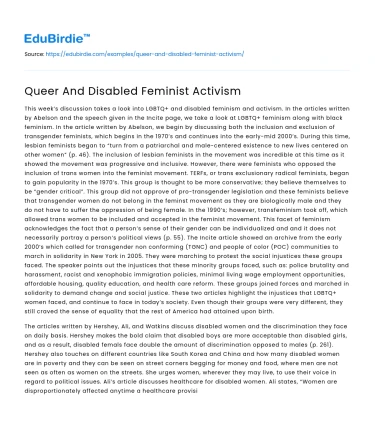This week’s discussion takes a look into LGBTQ+ and disabled feminism and activism. In the articles written by Abelson and the speech given in the Incite page, we take a look at LGBTQ+ feminism along with black feminism. In the article written by Abelson, we begin by discussing both the inclusion and exclusion of transgender feminists, which begins in the 1970’s and continues into the early-mid 2000’s. During this time, lesbian feminists began to “turn from a patriarchal and male-centered existence to new lives centered on other women” (p. 46). The inclusion of lesbian feminists in the movement was incredible at this time as it showed the movement was progressive and inclusive. However, there were feminists who opposed the inclusion of trans women into the feminist movement. TERFs, or trans exclusionary radical feminists, began to gain popularity in the 1970’s. This group is thought to be more conservative; they believe themselves to be “gender critical”. This group did not approve of pro-transgender legislation and these feminists believe that transgender women do not belong in the feminst movement as they are biologically male and they do not have to suffer the oppression of being female. In the 1990’s; however, transfeminism took off, which allowed trans women to be included and accepted in the feminist movement. This facet of feminism acknowledges the fact that a person’s sense of their gender can be individualized and and it does not necessarily portray a person’s political views (p. 55). The Incite article showed an archive from the early 2000’s which called for transgender non conforming (TGNC) and people of color (POC) communities to march in solidarity in New York in 2005. They were marching to protest the social injustices these groups faced. The speaker points out the injustices that these minority groups faced, such as: police brutality and harassment, racist and xenophobic immigration policies, minimal living wage employment opportunities, affordable housing, quality education, and health care reform. These groups joined forces and marched in solidarity to demand change and social justice. These two articles highlight the injustices that LGBTQ+ women faced, and continue to face in today’s society. Even though their groups were very different, they still craved the sense of equality that the rest of America had attained upon birth.
The articles written by Hershey, Ali, and Watkins discuss disabled women and the discrimination they face on daily basis. Hershey makes the bold claim that disabled boys are more acceptable than disabled girls, and as a result, disabled femals face double the amount of discrimination opposed to males (p. 261). Hershey also touches on different countries like South Korea and China and how many disabled women are in poverty and they can be seen on street corners begging for money and food, where men are not seen as often as women on the streets. She urges women, wherever they may live, to use their voice in regard to political issues. Ali’s article discusses healthcare for disabled women. Ali states, “Women are disproportionately affected anytime a healthcare provision gets gutted,” Carrie Wade, program manager of the American Association for People with Disabilities, explained to Ms. ‘Healthcare services that people often file away as women’s issues. Those sorts of things are often the first to go.’” Ali talks about how there was a bill that would result in billions of dollars worth of Medicaid cuts; Medicaid covers nearly 70 million people, including over 10 million disabled people, and women would have the most at stake if the bill became a law (Ali 2018). In the article written by Watkins, she speaks from personal experience of being a disabled black woman and how potential cuts to her medical care would drastically affect her. She talks about how she needs medical equipment, in-home care, and other resources that are funded by her medical care. If there were pay cuts, she most likely would not have access to the necessary care for her and her family would need.
Save your time!
We can take care of your essay
- Proper editing and formatting
- Free revision, title page, and bibliography
- Flexible prices and money-back guarantee
During week five of our course, we were required to read a statement from the Combahee River Collective which discussed black feminism their efforts to end racism, discrimination and class oppression. The speaker states, “As Black women we see Black feminism as the logical political movement to combat the manifold and simultaneous oppressions that all women of color face.” This group and the group from this week’s reading were fighting for similar rights and privileges in their distinctive groups. The black feminists and the LGBTQ+ feminists speak similarly on the topics of discriminaition and oppression.
Overall, this chapter showed me the struggles that many women face on a daily basis for things that they were born with. The part that interested me the most was the fact that some feminists did not want to be associated with transgender women who just wanted to support the cause. Another thing that shocked me was the amount of cuts that could potentially be cut from Medicaid and how many people that this pay cut could potentially affect. I did not know that nearly 70 million people were on Medicaid, and 15% of that are people who have disabilities. Without Medicaid, this 15% would not have access to viable resources that they need to live. Although I could not make a personal connection with the material discussed this week, I gained a strong incite on the struggles of queer and disabled women and the struggles that they still face today. Women, regardless of their preferences and beliefs, should come together in solidarity and fight for equality until it is achieved.






 Stuck on your essay?
Stuck on your essay?

